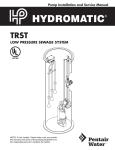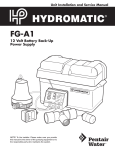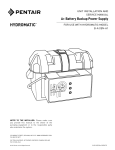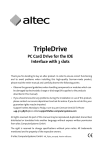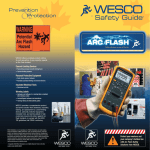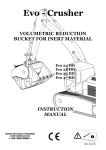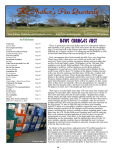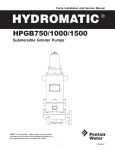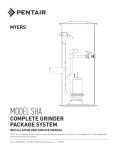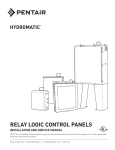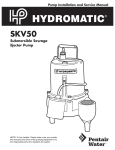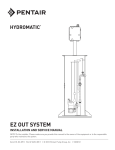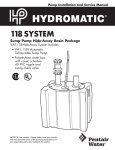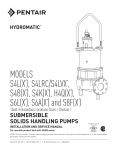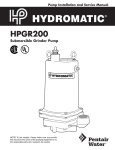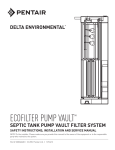Download LOW PRESSURE SEWAGE & EFFLUENT SYSTEMS
Transcript
Pump Installation and Service Manual TRST LOW PRESSURE SEWAGE & EFFLUENT SYSTEMS NOTE! To the installer: Please make sure you provide this manual to the owner of the pumping equipment or to the responsible party who maintains the system. General Information Thank you for purchasing your Hydromatic® pump. To help ensure years of trouble-free operation, please read the following manual carefully. Before Operation: Read the following instructions carefully. Reasonable care and safe methods should be practiced. Check local codes and requirements before installation. Attention: This manual contains important information for the safe use of this product. Read this manual completely before using this product and refer to it often for continued safe product use. DO NOT THROW AWAY OR LOSE THIS MANUAL. Keep it in a safe place so that you may refer to it often. Unpacking Pump: Remove pump from carton. When unpacking unit, check for concealed damage. Claims for damage must be made at the receiving end through the delivery carrier. Damage cannot be processed from the factory. WARNING: Before handling these pumps and controls, always disconnect the power first. Do not smoke or use sparkable electrical devices or flames in a septic (gaseous) or possible septic sump. 2 Systems Description: Four basic models of the Hydromatic TRST grinder systems are covered by these instructions: 1. FBTRSTSG Simplex TRST system using a fiberglass basin. 2. TRSTS Simplex TRST system installed by others in a concrete basin. 3. FBTRSTDG Duplex TRST system using a fiberglass basin. 4. TRSTD Duplex TRST system installed by others in a concrete basin. Factory built fiberglass basin systems are available in 24" minimum diameter basins for simplex systems and 36" minimum diameter for duplex systems. In a TRST system, the pump is raised and lowered in the basin while being guided by a fiberglass guiderail. A hydraulic sealing flange at the pump discharge allows the pump to be removed without disconnecting piping or electrical connections. Application: These pump systems are basically designed for pumping fresh, effluent or sewage water with a pH ranging from 5 to 9, specific gravities from 0.9 to 1.1, viscosities ranging from 28 to 35 S.S.U. and temperatures up to 140˚ F. WARNING: Pump is not to be installed in locations considered hazardous in accordance with the National Electric Code ANSI/NFPA 70. Pump Models: The TRST rail system may employ any Hydromatic 2 HP submersible grinder pump that uses cutter blades to grind solids into a slurry. The TRST rail system may also employ any Hydromatic 1" maximum sphere size handling effluent pump. Effluent is clear liquid waste left in a septic basin after the solids settle to the bottom. Refer to the pump service manual for all Hydromatic pumps when adjusting, dismantling, or repairing the pump. Inspection: Check to be sure that all items for your particular system are included. Check that the phase and voltage on the pump nameplate are correct as ordered and match available job site voltage. Codes: WARNING: To reduce the risk of electric shock, electric installations shall be in accordance with the National Electric Code and all applicable local codes and ordinances. Consult the local inspector(s) before installation to avoid costly delays or rework. Excavation Location: Excavation location shall be made according to local codes and regulations. Care should be taken to avoid buried utility lines piping, and other buried structures and foundations. Pump Installation Installation Skill Requirements: The installation of a TRST basin system is a specialized skill, which requires individuals with a basic understanding of excavating, pipe fitting, and electrical wiring. Hydromatic cannot assume responsibility for problems or damage resulting from inexperienced or undersupervised laborers. These instructions are meant only to be an installation guide; therefore, installation conditions not covered in these instructions rely on the experience and mechanical aptitude of those installing the system. Grinder Pump Attachments: Step 1 Attach the stainless steel foot bracket to bottom of the pump with two bolts and lock washers provided. See Figure 1. check valve threads and screw the valve into the pump discharge. For vertical discharge pumps, apply pipe thread sealant to pipe threads and screw the discharge piping assembly into the pump discharge. Tighten piping until a measurable distance of 23-3/4" ±1/8" from the floor to the center of the ball check valve discharge diaphragm hole is achieved. See Figure 2. 23-5/8" to 23-7/8" HORIZONTAL VERTICAL Figure 2 Step 3 Install the stainless steel lifting bail to pump with two bolts and two lock washers provided. Position the lifting bail with mounting tabs directed toward the pump power cord. See Figure 3. Step 4 Attach lifting chain, cable or rope as supplied to the lifting bail shackle. Tighten threaded shackle pin with pliers. WARNING: To reduce risk of electric shock, do not connect conduit to pump. Concrete Basin Installation: Step 1 Concrete basin must be a minimum of 24" diameter for a simplex station and a minimum of 36" diameter for a duplex station. Step 2 Basin floor must be level for pumps to be orientated properly. Step 3 Cast four 1/4" threaded studs into basin floor located per installation drawing. Studs should protrude a minimum of 3/4" from basin floor. Step 4 Grout in any discharge, inlet or overflow pipes. Correct positioning is the responsibility of the installer. DO NOT locate the influent line where it would empty on the guiderail. NOTE: 1-1/2" NPT coupling mounted flush to inside basin wall is required for discharge hub mounting (see above). Figure 1 Step 2 For horizontal discharge pumps, apply pipe thread sealant to the ball VERTICAL Figure 3 Step 5 For vertical discharge pumps, mount stainless steel discharge pedestal to the four threaded sump floor studs. Step 6 Apply thread sealant to the stainless steel discharge hub and thread into flush mounted 1-1/2" NPT wall coupling. 3 CONCRETE BASIN INSTALLATION: 1- 1/2" X 1-1/4" REDUCER COUPLING MOUNTED FLUSH TO INSIDE BASIN WALL (BY OTHERS) INLET (BY OTHERS) 1- 1/4" DISCHARGE (BY OTHERS) FOUR 1/4" STUDS (BY OTHERS) Pump Installation Step 7 Ensure discharge pipe length is correct. For vertical discharge pumps, measure the distance from the center of the discharge hub opening to the top of the installed riser pedestal. For horizontal discharge grinder pumps, measure the distance from the center of the discharge hub opening to the sump floor. Subtract 8-3/16" from the previous measurement to calculate the pipe length required. If supplied pipe is incorrect, cut pipe and install a solvent weld pipe coupling to achieve the correct dimension. 4 Step 8 Assemble discharge elbow, pipe, and shutoff valve using pipe sealant on all threads. Tighten threads until correct discharge height is achieved. Step 9 Ensure O-ring seal is in place on shutoff valve, then mount unit into place using six lock washers and screws provided. Step 10 Install all other components as depicted by installation drawing. Excavation for Fiberglass Basin Systems: Step 1 Effect appropriate excavation based on size of the basin, desired entrance point of the influent line, and entrance of power connection. Step 2 Obtain proper backfill material. The backfill material provides as much as 90% of the basin’s support under certain stress conditions. The installer must be positive that correct bed and backfill materials are used per instructions as follows: A. Gravel–clean and free flowing with particle size not less than 1/8" nor more than 3/4" in diameter. Use this description when ordering or specifying as material varies upon geographical location. This material is commonly known as “pea gravel”. B. Stone or gravel crushings with angular particle size of not less than 1/8" nor more than 1/2" diameter, washed and free flowing, is acceptable as an alternative material. CAUTION: In freezing conditions the backfill must be dry and free of ice. Do not use other backfill materials. The basin warranty is automatically void if materials other than the recommended bed and backfill materials are used. Step 3 The entire periphery, including under the basin, requires 4 to 6 inches of appropriate fill. The ideal basin pad is concrete in conjunction with anti-flotation tie-down studs. Basin anti-flotation tie-down kits are available from Hydromatic. If concrete pad is not used, the aggregate must be compacted to 85% standard proctor density. Concrete pad or aggregate surface must be leveled flat and free of voids to conform to the basin bottom. Basin bedding depth should be calculated such that the basin top will protrude 3" above the normal grade upon final installation. CAUTION: If the basin is not tied down during installation, rain or flood conditions may cause the basin to float upward, causing damage to the basin or basin connections. Claims for this type of damage cannot be processed by Hydromatic. Basin System Handling: Factory built fiberglass basin systems must not be dropped, dragged, rolled, or handled with sharp objects. Improper handling of basins may result in damage to the basin, damage to basin components, or leaks in the piping assemblies. Fiberglass Basin: Step 1 Inspect the fiberglass guiderail to ensure it is securely fastened to the basin wall. Step 2 An inlet grommet is the standard supplied influent connection device. If another type of inlet hub is used, refer to the directions included with the hub. Inlet grommet: Determine point at which influent line will enter basin and, using a hole saw sized per chart below, drill a hole through the basin wall. Clean cut hole and apply a sealant coating to the cut section to prevent fiberglass deterioration. Insert the inlet grommet into the drilled hole. PIPE SIZE HOLE SAW DIAMETER 3" 4" 4" 5" 6" 7" Step 3 Lifting of the basin may be done with a nylon or other nondamaging type material sling. Do not wrap a chain or steel cable around the basin as damage may result. Do not attach lifting mechanism around discharge hub or electrical hub. Step 4 Lower the basin into excavation, position and level properly. Mount basin with base anchor bolts if an anti-flotation tie-down kit is used. Inspect fiberglass basin and seal off any cuts or scratches to prevent fiberglass deterioration. Influent and Discharge Connections for Fiberglass or Polyethylene Basins: Step 1 Lubricate inside lip of inlet grommet with pipe soap. Clean outer end of influent pipe and push pipe through grommet. Ensure pipe does not protrude inside of basin so as to interfere with pump removal or float switch operation. Step 2 Close shut-off valve and make discharge line connection. It is recommended that an additional shut-off valve and redundant check valve, by installing contractor, be located outside the basin. This can be at any force main entrances – check local codes for specific requirements. Internal Basin Connections: Step 1 If system is supplied with a float bracket, attach float switches to the float bracket by clamping strain relief bushings around the float cords, then inserting and twisting the bushings into the float bracket slots. Step 2 After grinder pump attachments have been made, lower the pump unit down the guiderail to ensure the ball check valve's sealing flange aligns and connects properly with discharge elbow. Pedestal Panel Mount Systems: Step 1 Ensure power source is off or disconnected. Step 2 Place insulator strip or bushing onto sump cover opening to protect insulation on incoming cords. 5 Pump Installation Step 3 Insert all cords through the cover opening and then through the pedestal. Mount the pedestal on sump cover with vent openings pointing downward. Step 4 Mount sealing block and panel to pedestal with hardware provided. Ensure pedestal gasket seals against panel, and tighten all cord nuts while leaving approximately 3" of play in the cords from the tank. IMPORTANT: Any unused holes in the sealing block must be plugged to prevent the corrosive atmosphere of the basin from entering the control panel. Plug any unused hole(s) with the nylon plug(s) provided. Junction Box & Direct Burial Cable Systems: Step 1 Ensure power source is off or disconnected. Step 2 Push pump power/seal failure/heat sensor cord and float cords through cord grips in the junction box and tighten. To prevent corrosion or electrical short, plug any unused holes in junction box. Step 3 Remove junction box cover and make all connections inside junction box to all incoming control panel wires. 6 Step 4 Junction Box Conduit Systems: It is recommended that the customer furnish and install a conduit seal outside the basin to prevent surface water from entering the junction box. Direct Burial Cable: Incoming burial cable(s) must be fed through basin cord grip(s), then tightened. Panel Wiring: Step 1 Ensure power source is off or disconnected. Step 2 Connect pump power, seal failure/ heat sensor, and float cords to panel terminals per the schematic provided. If the pump is single phase, the white, black and red power leads must be connected to the proper terminals in the control panel marked “W”, “BK” and “R” or the pump will not operate. All conduits and cables entering the panel must be sealed off. NOTE: A Hydromatic approved control panel must be used or the pump warranty is void. IMPORTANT: Properly connect the panel ground wire to a grounding rod. Improper grounding voids warranty. Preoperation (Grinder Pumps): Step 1 Remove pump from basin. Step 2 With power off, turn radial cutter with a screwdriver to be sure it rotates freely. If necessary to adjust, refer to pump service manual. Step 3 Stand clear from pump and with power on, check for proper rotation of pump by turning H-O-A switch to Hand momentarily and then Off. The impeller should turn counterclockwise when viewed from the suction end. If rotation is wrong or pump does not rotate, turn main power source off, then for single-phase pumps: Check panel wiring to ensure white, black, and red pump leads are connected according to the schematic and panel wire labels. Single phase pumps will run only if connected one way. for three-phase pumps: Interchange any two line leads to the motor inside the panel. IMPORTANT: Do not leave pump in basin unless it is placed in operation. If a pump has been out of service for an extended period of time, with the power off, rotate the impeller by turning the radial cutter with a screwdriver to be sure it rotates freely. FINAL BACKFILL FOR FIBERGLASS BASIN SYSTEMS 4" to 6" 3" 12" INLET 1-1/4" DISCHARGE BACKFILL ANCHOR BOLTS (ANTI-FLOTATION FLANGE MOUNTING) 4" TO 6" BEDDING (CONCRETE PAD OR AGGREGATE) Refer to section “Excavation” for Fiberglass Basin Systems” for proper backfill materials. Ensure backfill material is free of rocks, clods, and debri. CAUTION: In freezing conditions the backfill must be dry and free of ice. Support for all piping and electrical lines must be provided during backfilling. At least a 4–6 inch wide band of compacted aggregate must be placed in successive layers (6" lifts) around the entire periphery of the basin. Carefully compact aggregate under all piping and electrical lines. Cover grade should slope down 3" to the normal surrounding grade. Care must be taken to prevent damage to any influent, discharge, or electrical connections made to the basin. 7 Pump Operations Step 1 Run clear water into the basin until motor housing is covered. Step 2 Open the shut-off valve to the discharge line. CAUTION: Do not use excessive force when operating the shutoff valve or damage to the valve or valve handle may occur. The valve is closed when a noticeable stop is felt upon closing. The valve is completely open upon 9 full counterclockwise turns from the closed position. Step 3 Turn H-O-A switch to the Off position and turn on main breaker. Step 4 Start the pump by turning the H-O-A switch to the Hand position. Step 5 Check the pump amperage with clamp on ammeter on black pump lead. Readings higher than nameplate indicate clogged pump, miswiring, or improper voltage. If basin is not being pumped down and amperage readings are considerably lower than nameplate, then the pump is air locked. NOTE: Nameplate amperage is rated at the largest impeller diameter trim. Pumps with trimmed diameter impellers will draw slightly less amps than nameplate. If pump is air locked, refer to the troubleshooting section in this manual. 8 Step 6 Float adjustment for simplex systems: Adjust floats so that the pump starts when the water level is just above the pump motor housing, and the pump shuts off when the water level is 2 inches above the pump volute discharge. Float adjustment for duplex systems: Adjust floats so the lead pump will start when the water level is just above the motor housing. The lag pump start float should be 5 to 6 inches above the lead pump start float. Adjust pump shut-off so that water level is within 2 inches above pump volute discharge. Pumps should alternate starting, between each other, upon successive pumpdown cycles. To check lag pump level, set both H-O-A switches to Off position and allow water to surpass the lag pump level, then set both H-O-A switches to Auto position and both pumps should start. Turn off one pump and be sure second pump starts when lag pump level is reached on second trial. If pumps fail to cycle in this manner, retrace control float wiring panel. Step 7 Ensure H-O-A switch is set to Auto before placing system into service. Pump Troubleshooting Below is a list of common problems and possible solutions. Refer to the pump and panel installation and service manuals for details regarding any necessary adjusting, dismantling or repair work. Pump Runs but Does Not Pump Down the Basin with the H-O-A Switch in Either Hand or Automatic Position. 1. Cutters may be clogged. Amperage higher than nameplate may indicate this problem. 2. Pump rotation may be reversed (on three-phase pumps only). Switching any two power leads on three phase pumps will correct the rotation. 3. Discharge gate valve may be closed. 4. Pump may be air locked. Fill basin approximately 10 inches or more above the ball check valve assembly. Raise pump assembly so that the ball check valve disengages the discharge elbow (approximately 6 inches). Stand clear from the sump opening to avoid spray and turn pump on for a brief second to clear trapped air in the volute. 5. Clogging anywhere from cutters to check valve. This is evident if no water discharged out of the check valve after raising the pump to disconnect the sealing flange. Pull pump assembly and check for cause of clogging. 6. Discharge head may be too high. Check elevation against design point of pump. 7. Clogging beyond the sealing flange. This is evident if water is discharged through the check valve when raising the pump from the disconnect sealing flange. Inspect system basin piping or discharge piping from basin to locate clogging. Basin Level is Pumped Down With H-O-A in Switch Hand Position, but is not Pumped Down with H-O-A Switch in Automatic Position. 1. Floats are not hanging free in the basin or are dirty. Pump the level down with the H-O-A switch on Hand, so that the floats can be observed. Relocate and clean float(s) as necessary. 2. If this is a new installation and original startup, the floats may be miswired into the control panel. If the On and Off floats are reversed, the pump will short cycle on and off and will not pump the level down. 3. Floats or alternator are malfunctioning. Pull the floats out of the basin and hang the Off and On floats from your hand. Turn the H-O-A switch to Auto. Tilt the Off float so that the large end is above the cord end – nothing should happen. While keeping the Off float tilted, tilt the On float in the same manner – the pump should come on. Suspend the On float again from your hand – the pump should continue to run. Finally, suspend the Off float – the pump should stop running. If this procedure does not cause the pump to operate as described, either replace the float(s) or replace the alternator relay if the system is duplex. Seal Failure Light Comes On. This may indicate that the lower seal has failed and has allowed water to enter the seal housing and made contact with the seal failure probe. Or this may indicate that a control circuit has become grounded. Check out all control circuit wiring for moisture. If this is not the case, then the pump must be pulled for maintenance. Refer to pump installation and service manual for replacing the lower seal. NOTE: Use twisted shielded cable for seal failure cable runs in excess of 100 feet. Pump Run Light Stays On. 1. H-O-A switch may be in Hand position. 2. Lower float may have failed causing the pump to continue operating below the Off level. 3. Pump may be air locked. 4. Cutters may be clogged. Overload Trips, Is Manually Reset, and Then Trips Off Again. 1. Cutters may be clogged. It is possible that the pump stalled during operation, and starting and stopping cleared the cutters. If resetting the overloads solves this problem, return the H-O-A switch to Auto and observe operation. 2. Pump motor may have failed. 3. Start component(s) failure for single phase pumps. Check start capacitor and start relay for failure. 4. Single phase pump may be miswired to panel. The white, black, and red pump power leads must be connected correctly to panel. Circuit Breaker Trips When Pump Tries to Start. 1. Short circuit in pump motor. 2. Water may have entered the motor housing through either worn-out mechanical seals or O-rings. 3. Contactor failure for three phase pumps. Check pump contactor for burnt contacts. 4. Start component(s) failure for single phase pumps. Check start capacitor and start relay for failure. 5. Single phase pump may be miswired to panel. The white, black, and red pump power leads must be connected correctly to panel. 9 TRST Parts List ORDERING REPLACEMENT PARTS: Product improvements are made from time to time. The latest part design will be furnished as long as it is interchangeable with the old part.When ordering replacement parts, always furnish the following information: (1) pump serial number, (2) pump model and size, (3) part description, (4) part number, (5) impeller diameter (if ordering impeller), (6) quantity required, and (7) shipping instructions. Ref. No. Part No. 1 2 3 4 5 6 7 8 *9 RTF 13712-001-3 156-023-1 101-022-1 12745-200-5 11945-000-1 176-005-1 177-004-1 13325-100-3 Part Description Pump Pump Foot Bracket Flat Washer Screw Ball Check Valve Shackle Screw Lock Washer Guide Rail Clip Qty. Ref. No. Part No. 1 1 2 2 1 1 2 2 1 10 11 12 13 14 15 16 17 18 14068-XXX-3 12720-101-1 12331-XXX-3 176-003-1 177-004-1 12777-200-5 150-051-1 150-052-1 13294-XXX-5 Part Description Rail Guide Elbow Pipe Screw Lock Washer Shut-Off Valve O-Ring O-Ring Valve Handle Extension Qty. Ref. No. Part No. 1 1 1 6 6 1 1 1 1 *19 *19 *20 *21 *21 22 22 23 24 12746-211-5 12746-225-5 14116-004-3 13578-000-5 ***9043-100-5 12726-001-1 12726-003-5 14082-000-1 14079-000-1 Part Description Qty. Pipe Assembly – G1L/G1LX Pipe Assembly – HPG Lifting Bail – G1L/G1LX, HPG Riser Bracket – Fiberglass Riser Bracket – Concrete Discharge Hub – Fiberglass Discharge Hub – Concrete Seal Ring – Fiberglass Lock Nut – Fiberglass * For Anti-Siphon Piping Assembly: HPG/SPG - 12746-213-5 G1X/G1LX - 12746-215-5 *** For pedestal spacer (not depicted by drawing) xxx Part number changes per tank depth RTF Refer to factory Notes: S — Parts in Seal Kit C — Parts in Carbide Seal Kit I — Parts in Impeller Kit R — Parts in Rebuild Kit *Consult Factory TRST 10 1 1 1 1 1 1 1 1 Pump Notes ______________________________________________ ______________________________________________ ______________________________________________ ______________________________________________ ______________________________________________ ______________________________________________ ______________________________________________ ______________________________________________ ______________________________________________ ______________________________________________ ______________________________________________ ______________________________________________ ______________________________________________ ______________________________________________ ______________________________________________ ______________________________________________ ______________________________________________ ______________________________________________ ______________________________________________ ______________________________________________ ______________________________________________ ______________________________________________ ______________________________________________ ______________________________________________ 11 LIMITED PRODUCT WARRANTY HYDROMATIC warrants that its products are free from defects in material and workmanship for a period of twelve (12) months from the date of purchase or eighteen (18) months from the date of manufacture, whichever occurs first. ® During the warranty period and subject to the conditions hereinafter set forth, HYDROMATIC, will repair or replace to the original user or consumer parts which prove defective due to defective materials or workmanship of HYDROMATIC. Contact the nearest authorized HYDROMATIC distributor, HYDROMATIC authorized service center or HYDROMATIC for warranty service. At all times, HYDROMATIC shall have and possess the sole right and option to determine whether to repair or replace defective equipment, parts or components. Start up reports and electrical system schematics may be required to support warranty claims. Warranty is effective only if HYDROMATIC supplied or authorized control panels are used, where applicable. All dual seal pumps must have seal failure and heat sensors attached, functional and monitored for the warranty to be in effect. If a seal failure should occur, HYDROMATIC will only cover the lower seal and labor thereof. If the heat sensor and seal fail sensor is not attached and functional, the warranty is void. LABOR, ETC. COSTS: HYDROMATIC shall in NO EVENT be responsible or liable for the cost of field labor, removal and/or reinstallation charges of any HYDROMATIC product, part or component thereof, or the expense of freight. THIS WARRANTY WILL NOT APPLY: (a) to defects or malfunctions resulting from failure to properly install, operate or maintain the unit in accordance with printed instructions provided; (b) to failures resulting from abuse, accident or negligence; (c) to normal maintenance services and the parts used in connection with such service; (d) to units which are not installed in accordance with applicable local codes, ordinances and good trade practices; or (e) if the unit is moved from its original installation location; (f) unit is used for purposes other than for what it was designed and manufactured; (g) to any unit which has been repaired or altered by anyone other than HYDROMATIC, a HYDROMATIC distributor or a HYDROMATIC authorized service center and (h) to any unit which has been repaired using non factory specified parts/OEM parts. RETURN OR REPLACED COMPONENTS: any item to be replaced under this Warranty must be returned to HYDROMATIC in Ashland, Ohio, or such other place as HYDROMATIC may designate, freight prepaid. PRODUCT IMPROVEMENTS: HYDROMATIC reserves the right to change or improve its products or any portions thereof without being obligated to provide such a change or improvement for units sold and/or shipped prior to such a change or improvement. WARRANTY EXCLUSIONS: HYDROMATIC MAKES NO EXPRESS OR IMPLIED WARRANTIES WHICH EXTEND BEYOND THE DESCRIPTION ON THE FACE HEREOF. HYDROMATIC SPECIFICALLY DISCLAIMS THE IMPLIED WARRANTIES OF MERCHANTABILITY AND FITNESS FOR ANY PARTICULAR PURPOSE. Some states do not permit some or all of the above warranty limitations and, therefore, such limitations may not apply to you. No warranties or representations at any time made by any representatives of HYDROMATIC shall vary or expand the provision hereof. LIABILITY LIMITATION: IN NO EVENT SHALL HYDROMATIC BE LIABLE OR RESPONSIBLE FOR CONSEQUENTIAL, INCIDENTAL OR SPECIAL DAMAGES RESULTING FROM OR RELATED IN ANY MANNER TO ANY HYDROMATIC PRODUCT OR PARTS THEREOF. PERSONAL INJURY AND/OR PROPERTY DAMAGE MAY RESULT FROM IMPROPER INSTALLATION. HYDROMATIC DISCLAIMS ALL LIABILITY, INCLUDING LIABILITY UNDER THIS WARRANTY, FOR IMPROPER INSTALLATION — HYDROMATIC RECOMMENDS INSTALLATION BY PROFESSIONALS. Some states do not allow the exclusion or limitation of incidental or consequential damages, so the above limitation or exclusion may not apply to you. This Warranty gives you specific legal rights and you may also have other rights which vary from state to state. In the absence of suitable proof of this purchase date, the effective date of this warranty will be based upon the date of manufacture. – Your Authorized Local Distributor – USA 740 East 9th Street, Ashland, Ohio 44805 Tel: 419-289-3042 Fax: 419-281-4087 www.hydromatic.com © 2008 Hydromatic Ashland, Ohio. All Rights Reserved. ® CANADA 269 Trillium Drive, Kitchener, Ontario, Canada N2G 4W5 Tel: 519-896-2163 Fax: 519-896-6337 Part # 5625-370-1 Item # E-03-370 3/08












